Monday July 29, 2013
Acadia National Park
There’s no getting around having to take time out to do the business of life.
That’s what we do this morning. We order two new tires for Ruby to put on the rear where the old ones have started making noise. Seems they are cupped. This is something I have never experienced in my many years of driving. From what I read, this is likely due to the rear of the car being out of alignment since the tires on it are not cheap ones. The last time we had the alignment checked they said it was fine so this may take some looking in to. It was also time to clean the house. Vacuum, sweep, dust, shake the rugs. Doesn’t take much time if you have less than 300 square feet. That’s my kind of cleaning.
About 1:30 we finally set out for a light afternoon of adventure.
Usually for me this means let’s go down to the rocky shore.
So we head out to see Dorr Point and Compass Harbor not too far south of Bar Harbor on the Island’s east side. Should be a nice quiet hike since it isn’t a very well known one. Not in all the books for instance.
We pull in the very small unmarked parking lot and it is nearly full. There is a group standing there. Now what are the chances that we would run into a ranger led hike 5 minutes before it is starting?
I’m not very happy about this since I was hoping for a quiet solitary sort of walk through the woods to the shore. Do we come back another time? Do we join the walk? Well you just have to be flexible and I don’t have a back up plan so we park and join the group.
It seems we have stumbled on the ranger hike titled Missing Mansion. Perhaps this was meant to be given that we arrived exactly on time.
As is usual I have found in National parks, the ranger whose name I have of course unfortunately forgotten, is very informative. He seems to know everything, has lots of pictures and is a great educator. I give him an A+.
Through his efforts we learn a great deal about the amazing George Bucknam Dorr who is known as the father of Acadia National Park and whose property we are on. Well it was his until he left it to the park when he died in 1944. That’s Mr. Dorr in the photograph
We walk down what was the drive of the Dorr residence.
Our ranger asks us to imagine that we are approaching the house by carriage as Mr. Dorr’s guests would have done. 
Learning about Mr. Dorr means learning about the creation of Acadia National park. Mount Desert Island was a sparsely populated fishing area until 1844 when the celebrated landscape architect Thomas Cole visited and painted island scenes. Soon the island became a favorite summer locale for the wealthy including George’s father who built a home here in 1868.
George Dorr made the home, which he inherited after the death of his parents, his primary residence.
Inspired by Charles W. Elliot's campaign to preserve land on the island, Dorr became the most active member of the group, working to buy or receive gifts of land that would be made accessible to the public. He negotiated many of the transactions. He used fortunes he inherited from both his parents and later money donated by John D. Rockefeller Jr. He mapped many of the island's trails, and lobbied tirelessly for protecting the island - first as a national monument and then, in 1919, as a national park.
Dorr never married focusing his time, energy, intellect and fortune on preserving the natural beauty of his beloved island. Over four decades
he worked tirelessly to acquire tracts of land for protection persuading and cajoling others to give land or the funds to acquire it. He gave all the large parcels of his family land including the entire Sieur de Monts area and his home and grounds.
Dorr was the first director of the National Monument created by Woodrow Wilson and the first Superintendent when it became a National Park.
George Dorr loved this place and gave his life to it.
His great fortune dwindled to almost nothing from his passion for the park. He died with hardly enough money for his burial having used all of it to secure the National Park. I am appalled that his home ‘Old Farm’ was torn down in the early 1950’s. I guess it was just a different time and attitude toward preservation.
Today it would have been maintained, restored if necessary and preserved as an example of the “cottages” of the island and a central place in the creation of the park. Only of course if congress would approve the money which may be doubtful given the way they are currently acting.
Today our ranger paints a picture of the Dorr’s life in their lovely home. He takes us on a tour using pictures of the rooms for each of us to stand in the place where it would have been. All that is left is the foundation and grounds including the gorgeous coastline from which Dorr swam daily until the day he died.
I take almost no pictures on the hike/talk.
I am too busy absorbing all the information, walking through the house on the foundation, imagining the rooms from the pictures and listening to the stories of Dorr’s efforts to talk the State of Maine and the Congress into first a National Monument and then a National Park. The ranger has two men volunteer to read letters. The first reads the letter from Dorr to President Franklin Roosevelt offering to donate his house for the rest and relaxation of the President and his staff. The second reads the polite response from Roosevelt saying the president is not allowed to accept such gifts but Dorr could give the property to the Department of the Interior with the express request that the President and his staff have access to it. This is what Dorr did. The President never used it.
The house was demolished in the early 1950’s. John D. Rockefeller paid $5000 for the demolition. I wonder why, with his money, he didn’t pay for the restoration as a tribute to Dorr who gave everything he had to the park.
After walking through the house, the group moves down the back steps from the piazza to the coast line which the house overlooks. It is simply gorgeous. Here the ranger tells the tales of Dorr’s later life and illness, of his death in a smaller house on the property, of the decline and eventual destruction of the house after Dorr’s death. What a sad story about a man who gave so much to the park and all of us.
I try to remind myself it was a different time with different values but I’m still angry and sad for Mr. Dorr.
After the 90 minute tour we stay to have our quiet walk around as we had originally intended to do.
Knowing more about the life and sacrifices of George Dorr has made this a much more moving experience.
We take this path down to Dorr Point.
I pick my way carefully along the rock of the point.
What a gorgeous spot. I can’t even imagine owning such a beautiful setting, seeing it every day in every kind of weather and knowing that as long as I own it, it is protected from destruction. What a great satisfaction that would be.
I spend some time just enjoying the view Mr. Dorr so loved that he gave it to all of us to protect it and the land from the portable saw mills that were coming into the area.
In the picture above I’m sitting facing the left side of the point. This appears be private property now. Is this Compass Harbor? Not sure and forgot to ask. It’s lovely but there is no path or way down there from park property.
I’m not sure which cove/harbor is Compass Harbor.
Perhaps Dorr Point bisects Compass Harbor since the area to my left is also a semi circular beach beyond the rocks. I’m guessing this is the beach from which Mr. Dorr made his morning swims year round. There are paths to it and it is clearly park property although what I assume is a private home is peeking out of the woods to the right of the beach which you can see if you look closely
A closer look at the beach and the house.
Just a little beach cottage apparently with the same view Mr. Dorr enjoyed from a greater distance.
We walk over to the beach and find it is a cobblestone beach with lovely rocks AND a waterfall flowing right down onto the beach and out into the ocean. What a spot!! Where’s my chair? Another place to return for sitting and contemplation. My list is growing.
On the rock face just to the right of the waterfall wildflowers are growing. This is just a beautiful setting.
We go back to look more closely at the house without the entire group so we can get a better idea of what it must have been like.
We refer to the photograph I took of the map our ranger passed out to nearly everyone in the group. He had multiple copies of many of the pieces of informational handouts. He really was well prepared.
There are still three sets of stairs going of the back of the house down to the water. One went off the the Piazza on the far right, one went off the Terrace behind the dining room and one went off somewhere to the left of the Terrace. On the map it shows only one set of stairs but there were 3 that I walk today. I walk the far stairs up and then there is a landing over which I can walk to either or both of the others.
It does seem eerie to see these perfectly preserved stairs coming off the beach and into the woods. They have been here for over 140 years.
I’m approaching the Piazza and terrace. Trees grow where parties were held to put together Acadia National Park
I am standing on the right Terrace looking at the brick Piazza. All of the brick work is in the herringbone pattern and it too is still amazingly preserved after 140 years. The piazza ran from the den on the left in this picture across the parlor and around to the library which is on the right.
I step up from the Piazza into the house.
I am looking from the library out to the front door.
To my left is the dining room with this window below overlooking the back terrace. This is a picture of the picture of Mr. Dorr’s favorite view. It looks like winter to me. Of course at that time the entire back of the property was landscaped to take advantage of the breathtaking views. The park service has allowed nature to reclaim the entire property.
Here is the threshold of the house. The front stoop leading into the entrance porch. I am standing in the entrance doorway to the Hall.
This is one of the last pictures taken of Mr. Dorr with park staff. He is in the long cape like coat in the front row right. The superintendent who followed him after he retired is standing to his right. They all look so serious. Sorry for the reflections on the plastic covering.
As we leave the grounds I can’t help but wonder what George Dorr would think of what has happened to his house and grounds. It was this place which inspired his life’s work. I am sad that the house has nearly disappeared.
If you come, do take the tour, it has proven to be much more than a mere walk on the grounds could have been. A great deal of credit for that goes to the excellent ranger. I am embarrassed that I cannot recommend him to you by name.
After a quick stop at the Hannaford’s grocery in Bar Harbor, we are rather late getting back. What else is new??
It was a wonderful afternoon made even better by the happenstance of being in the right place at exactly the right time. And by having such an excellent and knowledgeable guide. He helped us all to understand how indebted we are to George Bucknam Dorr.


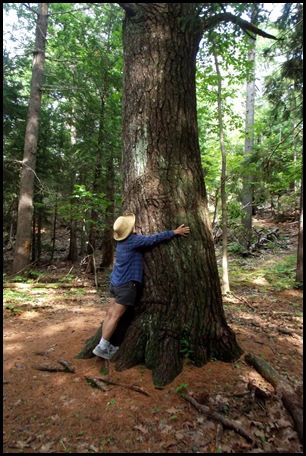



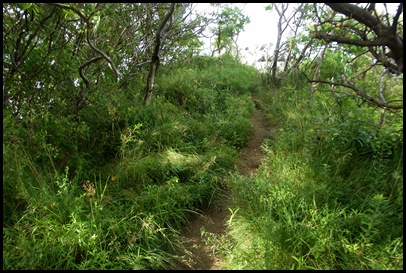












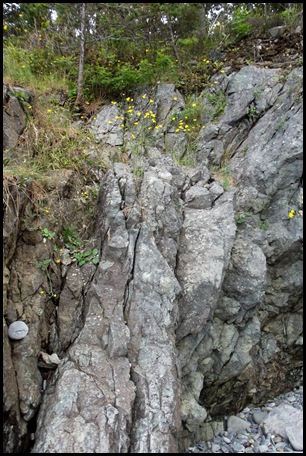


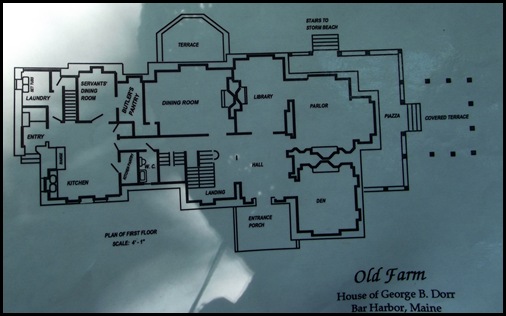






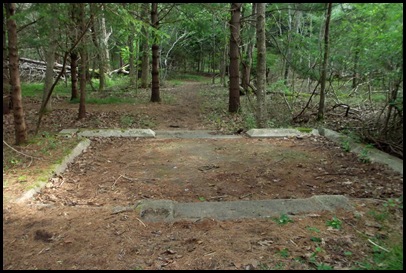

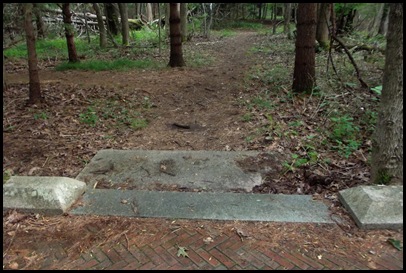

I went on several ranger led hikes and tours. Every single one of them was outstanding. My favorite one was "Focus on Acadia" . The photographer who happened to write the photography book on Acadia bridges happened to be the ranger leading the talk. Robert Thayer (I had to look it up). I didn't know that, so half way through the talk, he was saying something about one of the bridges and somebody asked if he could recommend a book about them. I piped up," I can!" And proceeded to give a glowing recommendation about the book. He says,"Oh! That's the book I wrote! And I didn't pay her a dime to say that, folks!"
ReplyDelete"indebted we are to George Bucknam Dorr" indeed. Each time I learn how these gorgeous places were preserved by men such as Mr. Dorr .. it boggles my mind to think of what would have been if these people didn't care.
ReplyDeleteAnother beautiful day, Sherry...
How serendipitous to come across the ranger walk. I am sure you learned a lot. Sounds like he was a terrific man.
ReplyDeleteI think the ranger-led hikes are great, and then you were still able to go off on your own after the talk. I am enjoying your posts and pictures on this area and would really love to spend a summer in Maine.
ReplyDeleteSounds like an excellent Ranger walk to have provoked you to feel the sadness at the loss of this physical piece of history. Definitely different attitude in the past to have razed this building. Glad the story is still being told. And such a marvelous man to give his all to create this gorgeous national park.
ReplyDeleteWonderful Ranger walk and your post made me feel like I was right there!! I am really going through Acadia withdrawal;o(( Keep the posts coming:o))
ReplyDeleteYou really got lucky showing up for the guided walk at the right time. It certainly is a shame that George Dorr's house was torn down. At least there are a few remnants of the house.
ReplyDeleteGreat post! Very interesting.
ReplyDeleteWhat perfect timing to happen upon the ranger walk. It is so interesting to learn the history of our parks. Makes one appreciate them even more.
ReplyDeleteWhat a wonderful gift to our nation. So sad the NPS couldn't find the money to keep up Dorr's house as a monument to his legacy. Sometimes, I just can't understand the way the NPS thinks.
ReplyDeleteI love learning the history of a place. It really puts all that you are seeing and experiencing into perspective. Love your tours.... another great place to put on the list!!
ReplyDeleteAs a person who often gives tours of the history and culture of our nation's wildlife refuges, I'd just like to say that it is always wonderful for the guide when he/she has such an appreciative audience as folks like you provide. Helping others to make personal connections to these special places is what it is all about.
ReplyDeleteReally like the picture of the boat at anchor:)
ReplyDeleteWhat timing to arrive just in time for the tour. It was meant to be. Thanks for passing on the story of such a generous man.
ReplyDeleteExcellent summary of our ranger led walk on the grounds of the Dorr property. Although it is part of Acadia NP, it is a part apart from the rest of the park and you would not run into it if you were not specifically going there. The ranger made all the difference in transforming a beautiful trail to the shore into a richer experience adding life with pictures and stories to help shape our minds eye to how it once was. Wish I had gotten his name as he was great and clearly had a passion for what he was doing.
ReplyDeleteExcellent timing for what sounds like was an excellent tour! I love Jeannie's comment about her experience with a ranger - he wrote the book she liked - what a coincidence! What a place Dorr worked to preserve - gorgeous view - unbelievable that house was destroyed - very unfortunate. I would have enjoyed that walk - great idea to imagine each room and to engage the audience allowing someone to read the letters. Beautiful coast spot - the person who owns that house...they have a mighty fine location there. Another great day :)
ReplyDeleteOur national parks are such a gift. It is wonderful to learn more history about them and those who made them possible. What a great post! Thanks!
ReplyDeleteOh, you are so right. The guide is everything. I went to Colonial Williamsburg two weekends ago and it was amazing how different the guides were. I had heard it all before, but was with a friend who was there for the first time. It made me crazy. Thank you for sharing this. I have got to make this trip!
ReplyDelete